Snack Mixes

By Paula Frank
Technical Editor, Food Product Design
Contents
Building a foundation
Deep fried
Going to the source
Lube job
Sticking with it
Snacks under cover
Savory's in season
Seasoning particulars
Say cheese
Holy smokes
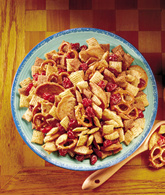
Snack mixes are tailor-made for the on-the-go consumer who demands instant
gratification and an assortment of flavor and texture at the same time.
Product offerings range from plain, roasted peanuts, pretzels, popcorn,
cereal and crackers to the highly seasoned variety. Some mixes contain
plain, chocolate or yogurt-coated dried fruit or nuts, while others
have bits of coated candy pieces, or dried legumes like peas. This article
focuses primarily on savory snack mixes.
Whether a substrate is fried, baked, extruded, or roasted, as in the case of peanuts, influences not only the selection of ingredients, but the application or coating process as well. Decisions made regarding ingredients, usage levels, and procedures during development impact finished product flavor, appearance and shelf-life stability.
Building a foundation
Each type of snack substrate has its own unique properties that define its
appearance, texture, eating quality and flavor. Consumers expect dense
and crisp pretzels, crunchy peanuts and light and airy cheese puffs. Cracker texture runs the gamut from light and flaky, to crispy and crunchy;
some have a dry and dusty surface appearance, while others have an oily
sheen.
Much of the textural variation among snack substrates is due to the composition of the dough. "The different starch types do have different inherent textures," notes Neil Grimwood, vice president of technical services and marketing, National Starch and Chemical Company, Bridgewater, NJ. "Corn tends to be more rigid and brittle, whereas tapioca tends to be lighter and less crunchy. Rice and waxy rice tend to produce very soft, tender snacks." Additionally, potato starch produces a light texture. In contrast, wheat flour, with a protein content ranging from 7% to 18%, develops one that is more dense.
The ratio of starch polymers is also a contributing factor to texture. "Amylopectin is known for giving expansion and an open kind of cell structure with good water binding," explains Grimwood, "whereas, with high-amylose starches you've got the complete reverse. They tend to give much denser, crunchier textures." Waxy maize, a hybrid of common starch, is practically all amylopectin, and used for a baked, sheeted snack where expansion is desirable.
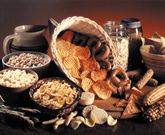
Instant starches are often preferred to the cook-up type, because in a low-moisture
system there isn't enough water available to fully hydrate a cook-up
starch. Plus, instant starches have higher moisture-binding characteristics,
and provide functionality in a warm or cold dough, unlike cook-up starches
that require an intermediate heat-processing step prior to forming or
expansion, says Grimwood.
Crackers and pretzels are baked to a low moisture content of approximately 2% to 3%, which helps extend shelf life. Although a built-in low-moisture system minimizes rapid staling, theory has it that starch polymers play an important role in the staling process as well. "Amylose retrogrades or associates almost immediately, so all the linear chains that diffuse out of the starch granule — the amylose — pretty much align themselves in a parallel fashion and give a firm structure very quickly," explains Grimwood.
"Amylopectin is a branched, more complex structure, and because of steric hindrance and the fact that it's a much bigger, bulkier molecule, it tends to retrograde at a much slower rate. A lot of theories now, certainly in the baking area, are that staling is not caused by amylose, but by amylopectin. In other words, it's this slow secondary retrogradation that causes staling in certain baked goods as well as moisture loss," he says.
The firmer texture associated with high-amylose not only minimizes moisture loss, but helps keep moisture from migrating in. Environmental moisture causes a loss of crispness and a softening of the chip or cracker. Using packaging with good moisture- and oxygen-barrier properties helps extend shelf life by preventing staling.
Deep fried
Certain snacks, such as potato chips and corn chips, are processed in a fryer.
Several factors influence the selection of the fat used for frying.
These factors include stability, melting point, flavor contribution,
nutritional profile and fat source. The choice ultimately determines
finished-product parameters including flavor, nutritional labeling and
appearance.
"Since snacks are served cold rather than warm like foodservice-type products, you have to be concerned with what the surface of the snack is going to look like" notes David Shockley, senior research scientist, AC HUMKO, Memphis, TN. The phase of the fat at room temperature defines the snack's surface appearance. For instance, a fat that is solid at room temperature leaves the chip with a dryer appearance than one that is liquid at room temperature.
"For snacks, generally it's either a partially hydrogenated high-stability oil that still remains liquid at room temperature, or it's a solid that generally melts below body temperature at about 95°F," adds Shockley. "This fat has a relatively high solids at 50°F, but only 3% or so at 92°F, and of course at 100°F, it is 0%. That way you still have something that sets up solid for your application and gives a better appearance, but still has a good melting point that doesn't give any waxiness or greasiness in the mouth," says Shockley. A frying oil that is liquid at room temperature (72°), would have a solid fat index (SFI) close to zero.
Certain degradative reactions occur during frying, such as oxidation and hydrolysis of free fatty acids. Oxidation occurs at the double bonds of unsaturated fatty acids. As a result, frying fats, especially those that are soy- or canola-based, are at least partially hydrogenated, which renders them less susceptible to oxidation. At the least, removal of two highly unstable polyunsaturates, linoleic and linolenic acids, improves stability.
Filtering the frying medium also minimizes the risk of oxidation and hydrolysis. Food particles and metals, along with other potential contaminants, are removed via this process. Adding a chelating agent, like citric acid, to the frying fat adds an extra measure of protection from oxidation promoted by metal contaminants. Antioxidants are also an option. Chemical antioxidants like BHA and TBHQ are commonly used, as are natural antioxidants, such as tocopherol or rosemary extract.
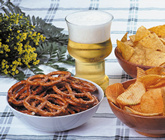
Going to the source
Soybean is one of the most common sources of fat used for snacks, although many
potato chip processors prefer cottonseed or peanut for their flavor.
The flavor of the oil is pertinent, because the substrate absorbs a
significant amount of oil upon frying. The potato chip, for instance,
has a pre-frying fat content of 0.1% and a post frying level of roughly
40.0%. These fats are refined, bleached and deodorized (RBD) to give
a bland flavor, but over time the flavor tends to regain characteristics
of the source. Peanut, sunflower and corn oils take on nutty notes,
canola and soy may become fishy or beany, and cottonseed can take on
a musty quality.
Using a higher-stability fat is critical with snacks, because of their long shelf life. Oxidative changes produce undesirable notes often described as painty, fishy or beany. Oddly enough, the characteristic aroma that escapes from a bag of chips when initially opened is slightly rancid, yet this is accepted and expected by consumers.
In light of today's focus on health and biotechnology, trans fatty acid content and genetically modified organism (GMO) status are often factors of consideration in the selection process. "In the United States, unless there are some very closely monitored sources or non-GMO oils, most of the common oils are from GMO sources, such as corn, cottonseed, soybean and canola," says Shockley. However, Trisun, a high-oleic sunflower oil, not only carries non-GMO status, but is very stable without hydrogenation.
On the other hand, hydrogenated fats may become an issue pending the outcome of looming legislation governing labeling of trans fatty acids. This legislation proposes to combine trans fatty acids with saturates and label them both as saturated fats. "The apparent saturated fat content of many foods would jump up by a considerable amount if they contain hydrogenated oils," notes Shockley. For a potato chip that's 40% oil by weight, this is significant, assuming the frying fat has extensive, but not complete, hydrogenation.
Lube job
Spraying a snack cracker with 15% to 17% oil by weight of the baked cracker reduces
the mouth-drying effect associated with a dry cracker. Oil also enables
seasonings to adhere to the surface of a substrate. In the case of potato or corn chips, seasonings are merely applied directly out of the fryer
while the oil on the chip is still warm. A fat with a high melting point
gives better adhesion than one that is liquid at room temperature, which
can cause the seasoning to slide off the chip. Also, an oily chip will
coat other snacks in the mix, as well as the interior of the package.
"If the oil is not applied at the right temperature, and is somewhat plastic, rather than being an adhesive, it will have the tendency to grab onto the seasoning, agglomerate it, and cause it to fall off," notes Lionel Vil, director of R&D for savory technology, Kerry Ingredients, Beloit, WI. "For example, if the temperature of the substrate is around 120°F when the seasoning is being applied, the surface oil from the fryer begins to plasticize, causing inconsistent coverage." With an oil-adhesion system, there are limits to the amount of seasoning that will stick to the surface of the snack item. Sometimes, so much oil is used that it affects the flavor of the seasoning, adds Vil.
When it comes to spray oil for seasoning adhesion, the ratio of oil to seasoning may be as high as 70:30, and for others as low as 50:50. "That's about as low as you'd go with the oil to keep things sprayable and moveable," notes James Blackwelder, director of product development for cheese powders, DairiConcepts, Springfield, MO.
In spite of the caloric and health implications associated with fat, it does add value from a flavor standpoint. When fat is removed for a low-fat application, "the hardest thing to overcome is the way the fat evens out the flavors and keeps everything in balance," says Blackwelder. An increase in flavor intensity often achieved with a higher level of salt helps compensate for the absence of fat from a flavor standpoint, as can use of fried-type flavors, although texture and mouthfeel may still be lacking.
Sticking with it
A non-oil carbohydrate-based coating system is a viable alternative to
an oil-adhesion system. However, there are inherent issues with using
such a system, such as the need for additional equipment and processing
steps to drive off moisture introduced in the aqueous-based mixture.
These extra steps may translate into additional equipment cost, but
the system is effective if done properly, and produces snacks much lower
in fat. Driving off excess moisture is important, as inadequate drying
can produce soggy or sticky products. Excessive heat, however should
be avoided or the secondary drying process can drive off flavor volatiles
and cause browning. "It's important that the coating is applied
to the snack and dried to the right moisture level," says Tonya
Armstrong, applications scientist, Grain Processing Corporation (GPC), Muscatine, IA. "If the coating
isn't applied and dried correctly, the seasoning won't coat evenly."
On a cereal-based snack, Armstrong recommends a coating level of 5% to 15% by weight, stressing 15% as a maximum. Using a 1:1 replacement of an aqueous-based solution for an oil-based slurry is one of the most common errors people make. "You certainly can't apply an aqueous coating with that type of heavy hand. You've got to really scale it down," says Mike Kramer, applications scientist for GPC, who's had success coating substrates with candy pans and regular drying ovens as opposed to equipment specifically designed for aqueous systems.
When using a tumbler pan, a series of nozzles spray a coating on the substrate as it rotates through a drum. With an aqueous coating, spraying and drying occurs at the same time as a tremendous amount of air is forced through the drum, explains Kramer.
An instant starch is generally a good choice for a non-oil-adhesion system, because it eliminates the heating step. "A lot of times heat is detrimental when you're coating something like a peanut, because it causes the oils to come out," notes Armstrong. Maltodextrin is often used in conjunction with starch in a coating system. It adds value by increasing the tackiness of the coating, as well as the speed of drying, plus it adds surface gloss.
An oil-based instant snack coating is a compromise between the traditional oil adhesive and an aqueous one. This slurry is a combination of oil, instant starch, emulsifier and water, which is sprayed onto a snack substrate at a level of 1% to 5% by weight. This type of system "gives the flavor impact of the oil, reduces the water in the coating, and is especially well-suited for cheese-based flavors, which require a little bit of fat for impact," says Kramer. Other benefits include a faster drying time and a reduced caloric content.
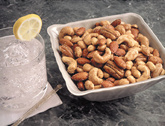
Snacks under cover
Coatings are applied to substrates for a variety of reasons. As previously discussed,
they function as adhesives for seasonings. Some film coatings act as
partial barriers to oxygen and moisture, while others provide texture,
improve appearance and protect snacks from breakage. Because carbohydrate-based
film formers are water soluble, they do not make great moisture barriers,
but "they can prevent some migration from occurring," notes
Armstrong.
Pretzels don't require an applied coating. The outer shell is actually formed during the baking process. After proofing, the pretzel moves through a curtain or bath of sodium-hydroxide solution. The subsequent surface alkalinity causes starch gelatinization, giving the pretzel its characteristic brown, shiny surface.
Roasting nuts not only increases shelf life by destroying microorganisms and lipase enzymes, but it impacts texture as well. When maltodextrin is used as part of a coating formula and roasting heat is applied, it adds crispness to the nut. A clear coat can be applied without seasoning, and is added mostly as a protection for the nut, explains Armstrong. Usage levels for a clear coat typically range from 1% to 3%.
An example of another type of coating is the seasoned crispy-coated nut "which is a dual-textured item that has a cereal-like blanket around the outside of the nut. It's like a peanut enrobed in an expanded breakfast-cereal coating that has between 75% and 125% pick-up by weight, so almost the full weight of the nut is on top with this coating," explains Kramer. "The eating quality of the crispy-coated nut is different than that of a spray-coated nut. The coating is a component of the snack matrix itself. It's not just something that's used to adhere the seasoning to the outside." While this type of coating was originally introduced in the Asian market, GPC modified it by adding American-style chip seasonings as a final step in the process.
"This product is prepared with a simultaneous roast and a coating bake," says Kramer. "Other formulations we've seen for this type of product require frying or a pre-roast on the nut. We think this is a somewhat simplified formulation in addition to being a simplified procedure for manufacturing. What you are trying to do is build up this half-solid, half-liquid matrix. When you roast it, the water comes out, and that adds to the expansion and the set of the cereal-type coating. This liquid, plus repeated coatings of solids, is a standard panning-type procedure, which is used when you want to build up a lot of solids onto the surface." Back to top
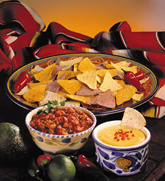
Savory's in season
Seasonings can be incorporated into snacks in one of two ways, either topically
or in the matrix itself. Ingredient selection may differ depending on
the method chosen. Seasonings used internally face rigorous processing
conditions, where flavors have a tendency to volatilize, and sugars
react with proteins causing browning and potential off-flavors. "Definitely
when applying seasonings for an internal application, we have to make
sure we use heat-stable flavors, and minimize the sugars. Also, if a
snack contains yeast to help it rise, then salt can be a problem, because
salt will limit how much the dough will rise," says Vil. Keep the
dough salt below 0.5% of finished product to minimize any negative impact
on the leavening process.
"Baking is pretty severe, especially for cheese and dairy-type notes, and it's hard to get flavor to stay in a baked cracker," notes Blackwelder. "We have seen some success with using some of the dairy ingredients, but you have to have a lot of flavor. There are ways to go about that. You can use really aged cheese, but it's rather expensive here in the United States, so that's not the typical way that's done. The cheese-making process can be manipulated to favor some specific fermentation to get some dramatic increases in flavor, but there are some issues with flavor balance."
"DairiConcepts is working on a new line of enzyme-modified cheese (EMC) specifically designed for baking applications," he continues. "The development effort in the whole enzyme-modifying process is geared for the high heat of the baking process. A lot of testing is being done with bakery applications to try and get those flavor compounds that will stay in the dough after heating."
Certain flavors are not necessarily impacted by processing conditions, although the perception differs depending on whether the flavors are used topically or internally in the dough. Smoke is one such flavor, says Ray Nemunaitis, vice president of sales and marketing, Hickory Specialties Inc., Brentwood, TN. Whether or not the smoke clears the palate early on or later in the flavor profile is indicative of the location of the flavor relative to the substrate. In a topical seasoning, smoke hits the palate up front, notes Pat Moeller, vice president of research and development for the company. When used in a dough, complementary surface tastes hit first, followed by smoke as an aftertaste, giving the impression of something having been cooked.
Encapsulation help deliver flavors intact. Spray-dried encapsulated blends using ingredients such as modified starches, gums and maltodextrin as encapsulant materials enable flavors to withstand harsh processing conditions encountered during baking or extrusion. "It is critical for the seasoning manufacturer to avoid excessive milling of the seasoning, because that could break up the encapsulate. If it does, the flavor's protection is lost," says Vil.
Seasoning particulars
Factors affecting seasoning adhesion to a substrate's surface include particle
size and density. Particles should be fine to avoid negatively impacting adhesion. Larger, dense particulates will simply roll off a substrate.
On the other hand, a larger, less dense particulate is more likely to adhere. A little more flexibility exists with internal seasonings, although
large particles may affect the dough's machinability, notes Vil. Large,
brittle particulates may also break during dough forming.
Particle size also impacts flavor perception. "In some cases, the more powdery a seasoning is, the more dull the flavor delivery, because it basically gives a straight-line-type flavor delivery," explains Vil. "Whereas different particle sizes affect the taste buds at different times, and therefore the perception in the palate is more complex. It gives the impression that you actually have a more sophisticated flavor delivery than you normally would. A bigger particle size takes a bit longer to dissolve, but once it hits, it gives a burst of flavor. So, there are times when using different sugars, or different acids allows the developer to manipulate the flavor perception of the seasoning."
According to Vil, usage levels depend on the intensity of the seasoning as well as the density of the substrate. Peanuts, which are dense, require merely 1% to 3% seasoning, a tortilla chip uses 6% to 8%, and the extruded, low-density corn puff may require as much as 10% or more.
The ingredient-selection process requires an awareness of regulations, processing conditions and finished- product specifications. Certain ingredients are permissible in the United States, but are not allowed elsewhere; therefore, knowledge of the intended customer base is critical. Color stability may be an issue, particularly with the use of natural colorants. Colors develop more fully in manufacturing because of excessive shear. Vil suggests various production-monitoring tools as a means of avoiding batch-to-batch variation and overheating. For instance, closely monitor the blender's speed and mix time, and lower the speed of the blender as it discharges the product.
In a snack mixture, ecognize that moisture migration might occur from one substrate to another. "Most critically, try to avoid using humectants," notes Vil. "Ingredients like sorbitol or fructose have a tendency to grab on to moisture, which will then reintroduce moisture to your product that might affect its ability to remain crisp. In addition, the overall moisture content of the seasoning needs to be low or some moisture from the seasoning could transfer into substrates composed of hygroscopic ingredients."
Seasonings may rub off from one substrate to another in a mix. Make sure, from a flavor standpoint, that a seasoning is not only compatible with the substrate it is applied to, but also with other substrates and flavors within the mix.
Say cheese
Dehydrated cheese powders are derived from a slurry after having been pasteurized
via vat-pasteurization or an HTST method. "HTST keeps the product
from being exposed to high temperatures for a long time, and thus doesn't
allow the flavor degradation that might be seen in vat pasteurization.
But the latter method gives some slightly cooked or warmed-over flavors
that can actually be beneficial to your finished slurry," notes
Blackwelder.
The slurry used in making dehydrated cheese powders contains not only a blend of cheese and water, but other lower-cost dairy ingredients, fillers, and flavoring ingredients. Once the slurry is spray-dried into a powder, it can be used directly to coat a corn curl, or added to a dry blend along with spices, fillers and other flavoring ingredients. Although dairy fats tend to oxidize, the spray-drying process adds a layer of protection allowing for a year's shelf life on the cheese powders without the need for antioxidants.
Natural colorants are susceptible to formulation and processing factors, such as pH and heat. The color of annatto, turmeric and paprika, may shift during processing. In the case of annatto, "pinking out" could result, or a color that is too yellow and not red enough, notes Blackwelder. Artificial colors, such as yellows #5 and #6, are far more stable during processing, and commonly used in cheese snacks, particularly in achieving the bright, orange color associated with cheese curls.
Acid is not only a problem for natural colors, but it can affect the efficiency of the spray-drying process for cheese powders. Minimizing the amount of acid in the cheese slurry and incorporating the balance into the dry blend avoids compromising drying efficiency, suggests Blackwelder. "A slurry can always be dried, even at the low pHs, but it's not as efficient and counterproductive. Typically a pH of 5.5 is a good minimum number to keep in mind."
Salt is also an issue if added directly to the slurry, as in the case of a cheese powder destined for direct application to a corn curl. Dryer efficiency isn't compromised, as long as added salt is below 9%. Finally, avoiding long exposure to high temperatures prior to spray drying prevents discoloration and off-flavors in cheese powders.
Holy smokes
Smoke ingredients not only contribute flavor, but color and texture as well.
Mesquite smoke provides a golden yellow color, while smokes derived
from hardwoods, such as hickory, appear mahogany to reddish-brown. "Mesquite
contains a higher level of phenolic compounds (than hickory and other
hardwood smokes), which are primary flavor components," says Moeller.
Hickory and mixed woods containing predominantly hickory, and other
woods such as oak and ash, have different ratios of phenol types, as
well as different phenolic compounds in general, in addition to various
acids which create different flavor nuances.
A particular type of smoke flavor from Hickory Specialties Inc., called Zesti Advantage, contributes color and surface texture without imparting smoke flavor. "The product essentially has no smoke flavor, but may contribute to roasted flavor notes due to its interaction with proteins," says Nemunaitis. From a textural standpoint, Moeller compares the cross-linking of proteins that results from a reaction between this smoke flavor and proteins within a substrate to that of bread-crust formation or the skin formation on hot dogs. In other words, this reaction causes a cross-linking of proteins that aids in color development, texture improvement and crust formation. In addition to providing color, this product retains moisture and provides crispness to a substrate, and is labeled as natural flavor or natural smoke flavor.
Regardless of the seasoning's flavor profile, when mixing snacks together, make sure flavors and substrates blend well together. Protect snacks from environmental conditions by using coating and packaging barriers, and minimize use of humectant ingredients.
• Photo: The Cherry Marketing Institute
• Photo: National Starch and Chemical Company
• Photo: Blue Diamond Growers
• Photo: DairiConcepts
© 2000 by Weeks Publishing Company
Weeks Publishing Company
3400 Dundee Rd. Suite #100
Northbrook, IL 60062
Phone: 847-559-0385
Fax: 847-559-0389
